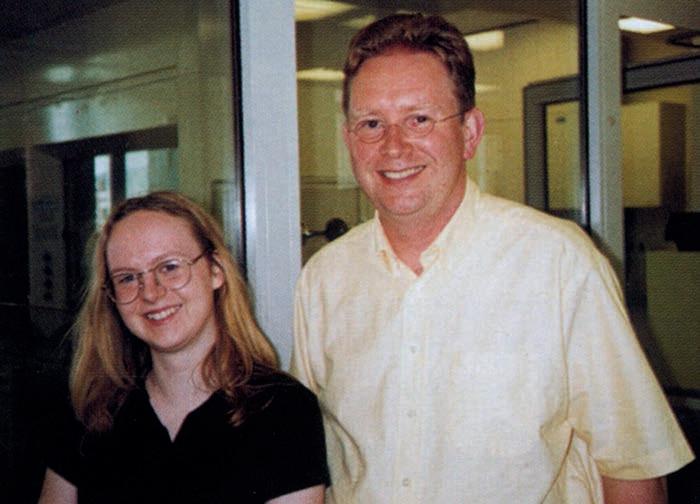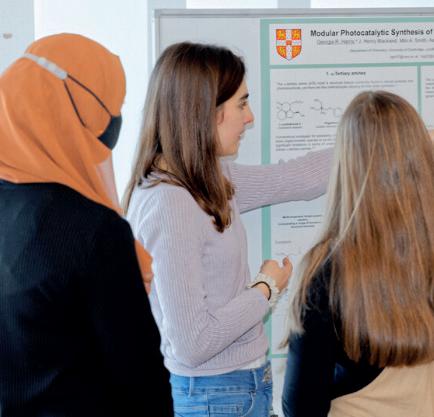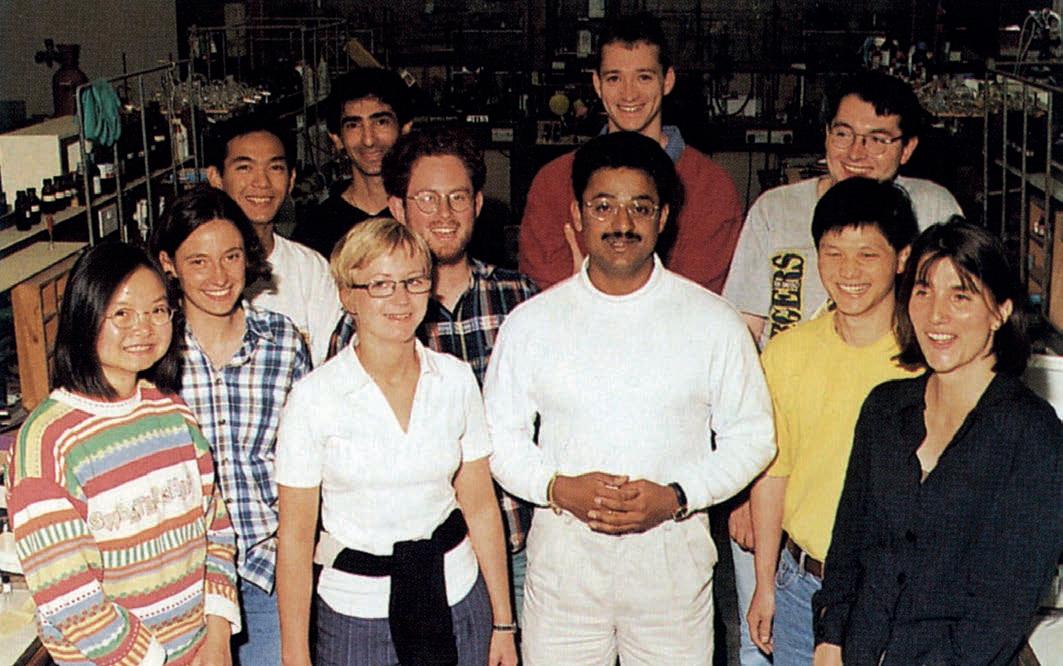
5 minute read
Paterson Group alumni: Where are they now? _________________________________________________________
Asymposium to celebrate the work of Professor Ian Paterson and his recent retirement was held at Jesus College in May. We caught up with three former Paterson group members who returned to speak at the symposium, including his rst and last group members.
Dr Victoria Steadman Vice President of Business Development and Integrated Partnerships, Sai Life Science Paterson Group member 1996-2000
Vicky Steadman has always enjoyed the exploratory nature of organic chemistry. “You come up with a hypothesis based on the literature and then you test it. If it doesn’t work you go back to the drawing board and try something else. It encourages problem solving, which is useful in everything, not just chemistry,” she says.
Vicky recalls the Paterson group as being very collaborative and supportive. “Ian was a great supervisor – he was friendly and encouraging, and always helpful with suggestions when things were not working as planned – which happens a lot in chemistry,” she says. “We also had a bit of a tradition of going to the Panton Arms, which was a lot of fun.”
After her PhD and a postdoc in the US, Vicky worked at Merck and then at GSK, but then decided to try a smaller company, so she joined Selcia, which worked with global pharma, biotechs and academics to carry out research on their behalf. “That was my rst experience of a contract research organisation,” she says.
During her 12 years at Selcia, Vicky gradually became more involved in business development, which suited her. “It’s one of those roles that not everyone could do as a chemist,” she explains. “You need to have a certain type of outgoing nature to get out of the lab – which is technically focused – into more of a relationship-building type of role.”
Two years ago these skills propelled Vicky to join Sai Life Science, an international contract research organisation which works with companies globally to provide research and development services. Vicky’s role is in business development, supporting the discovery side of Sai, with a particular focus on winning integrated partnerships.
Vicky was thrilled to be invited to speak at Ian’s retirement symposium in May. “So many people who I haven’t seen for years ew in from around the world, and it was interesting seeing all the di erent types of things they were doing– some are academics, some are high in industry, some in biotech, some patent attorneys. It was a wonderful reunion and fantastic to reconnect with people who I hadn’t seen for a very long time.”
Vicky was particularly pleased to speak at the symposium about how she had used Paterson’s own boronmediated anti-Aldol reactions and retrosynthetic approach to synthesise a set of molecules used in the treatment of hepatitis C and other diseases.
“What a pleasure it was both being a PhD student in Ian’s group, and to be invited to speak at the Symposium. Many thanks to Ian for everything.”
Dr David La an Former Senior Director of Chemical Development, AZ Paterson Group member 1985-88
David came up to King’s in 1981 to read Natural Sciences, and was surprised to nd himself drawn to organic chemistry, which appealed to him because of its visual nature. “It’s also an endless source of puzzles that you get to solve,” he says.
On the recommendation of his friend Varinder Aggarwal (now Professor of Synthetic Chemistry at the University of Bristol), David applied to complete a PhD with Ian Paterson.
David enjoyed his time in the Paterson group, where he and Ian Mason were Ian’s rst postgrads. David’s research project was on the total synthesis of erythromycin. “It was tough going,” he recalls. “You never get as far as you hope to get – that’s just life in research.”
After completing his PhD, David spent six productive years at Lonza, a contract development and manufacturing company in Switzerland, before joining Zeneca in 1995 (which became AstraZeneca after the merger in
David La an with Professor Ian Fleming at the symposium.
1999), where he has been involved at all stages of the drug development process, until his retirement in October.

At the symposium David spoke about the di culties of achieving AstraZeneca’s net carbon zero target for 2030.
“We’ve got a very good handle on what we can do for traditional small molecules, about how to make them more sustainable and improve the carbon footprint. But some new medicines such as oligo-nucleotides are much bigger and create more waste. We do have a plan for improving this, but we can’t just optimise what we have – we have to re-imagine the whole process.”
The company is working with the regulatory authorities and other pharma companies to meet their goals. “We recognise that it isn’t simply our problem, and we’re working with regulators, other companies and the UK government. It’s important to acknowledge that this doesn’t have to be an area that we compete with other pharma – we can collaborate.”
“It’s hard, but we know we can meet it. We know the direction we are going and that we will get better.”
Dr Tegan Stockdale Trainee Patent Attorney Paterson Group member 2017-2022
From Ian Paterson’s rst student we come to his nal group member, Tegan Stockdale, who passed her viva days before Paterson’s retirement symposium in May, earning the title “Dr” just in time for the programme.
Tegan might never have come to Cambridge at all but for Professor Mary Garson, Tegan’s friend and mentor at the University of Queensland, who was a contemporary of Ian here in the 1970s. Tegan recalls: “Mary said to me – you should spread your wings and apply to my old stomping grounds – and so I did.”
And what a nal student to have – Tegan had completed a Bachelor of Science in Chemistry and Biochemistry while also obtaining a Bachelor of Laws at the University of Queensland. She graduated the top of her honours year (roughly equivalent to a Master’s integrated research year).

Tegan is now a trainee patent attorney at D Young & Co in London. “I basically had to choose between passions,” she says. “But one of the things that truly inspires me now is seeing that scienti c research come to fruition and becoming implemented in the real world.”
Tegan is also completing a postgraduate certi cate in intellectual property law at Queen Mary University of Law. “I’m enjoying everything about my job and course – I don’t think there’s a day that’s gone by that I haven’t learned something new,” she says.
“There’s this term in patent law and biotechnology called synergy. You add di erent things together but the combination of the parts is more than what you would have expected. I feel that putting together my science knowledge and legal knowledge in this profession is a good example of that. The sum of its parts is much, much more.”










